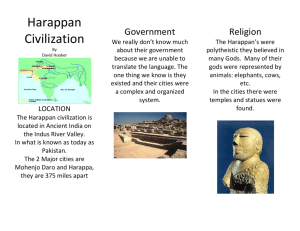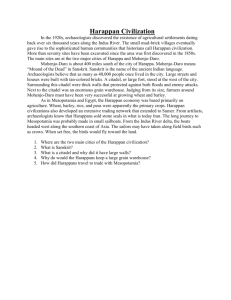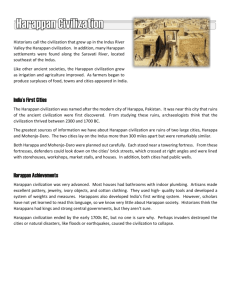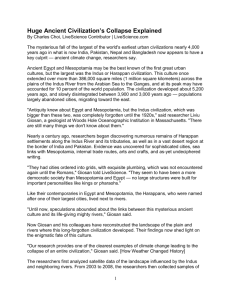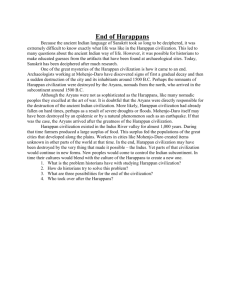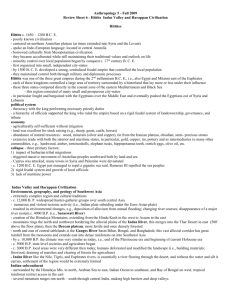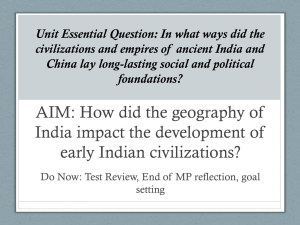Harappa and the Indus Valley
advertisement
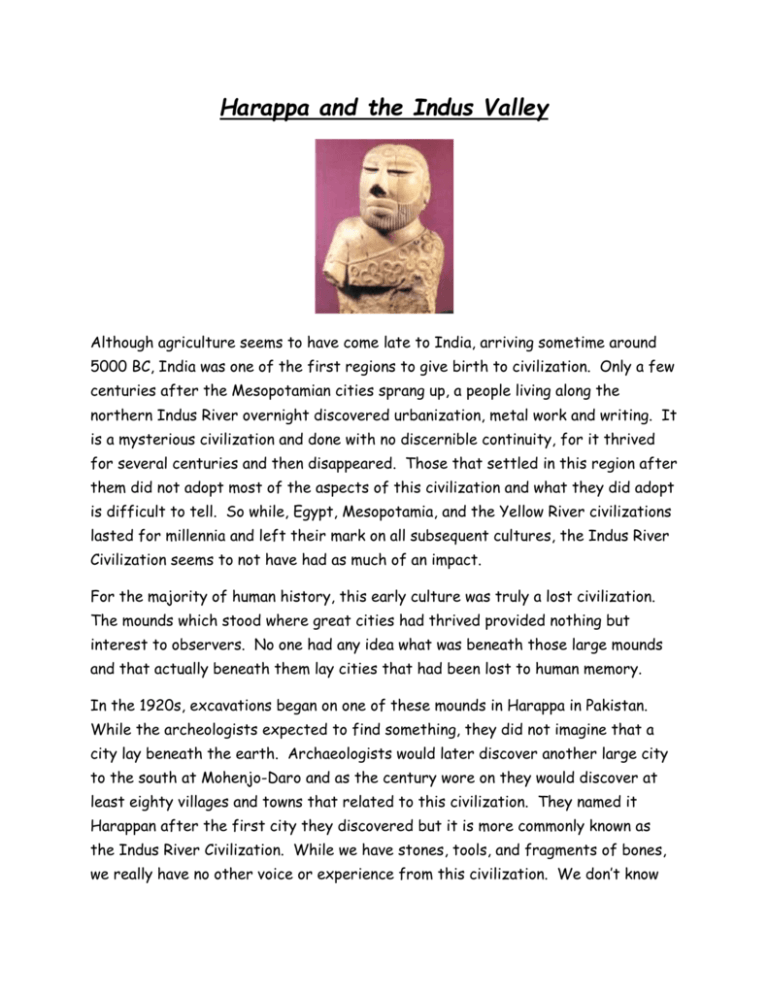
Harappa and the Indus Valley Although agriculture seems to have come late to India, arriving sometime around 5000 BC, India was one of the first regions to give birth to civilization. Only a few centuries after the Mesopotamian cities sprang up, a people living along the northern Indus River overnight discovered urbanization, metal work and writing. It is a mysterious civilization and done with no discernible continuity, for it thrived for several centuries and then disappeared. Those that settled in this region after them did not adopt most of the aspects of this civilization and what they did adopt is difficult to tell. So while, Egypt, Mesopotamia, and the Yellow River civilizations lasted for millennia and left their mark on all subsequent cultures, the Indus River Civilization seems to not have had as much of an impact. For the majority of human history, this early culture was truly a lost civilization. The mounds which stood where great cities had thrived provided nothing but interest to observers. No one had any idea what was beneath those large mounds and that actually beneath them lay cities that had been lost to human memory. In the 1920s, excavations began on one of these mounds in Harappa in Pakistan. While the archeologists expected to find something, they did not imagine that a city lay beneath the earth. Archaeologists would later discover another large city to the south at Mohenjo-Daro and as the century wore on they would discover at least eighty villages and towns that related to this civilization. They named it Harappan after the first city they discovered but it is more commonly known as the Indus River Civilization. While we have stones, tools, and fragments of bones, we really have no other voice or experience from this civilization. We don’t know who the people were who built and lived there and we don’t know when they built their cities. Like the civilization in Mesopotamia, Egypt, and Greece, Harappa grew on the floodplains of a rich and life-giving river, the Indus. The original cities and many of the towns seemed to have been put right near the shores of the river. The Indus, however, is destructive and unpredictable in its floods, and the cities were frequently leveled by the forces of nature. Mohenjo-Daro in the south, where the flooding can be fairly brutal, was rebuilt six times that we know about. Harappa in the north was rebuilt five times. The Harappans were an agricultural people whose economy was almost entirely dominated by horticulture. Massive granaries were built at each city, and were very elaborate in order to distribute the wealth of food. The Indus River valley is relatively dry now, but apparently it was quite wet when the Harapans thrived there. We know this because the bricks that they built their cities with were fired bricks; since sun-dried bricks were cheaper and easier to make, we can only assume that over-abundant humidity and precipitation prevented them from taking the cheaper way out. In addition, many of the Harappan seals have pictures of animals that imply a wet and marshy environment, such as rhinoceroses, elephants, and tigers. The Harappans also had a wide variety of domesticated animals: camels, cats, dogs, goats, sheep, and buffalo. Their cities were carefully planned and laid out; they are in fact, the first peoples to plan the buildings of their cities. Whenever they rebuilt their cities, they laid them out precisely in the same way the destroyed city had been built. The pathways within the city are laid out in a perpendicular crisscross fashion; most of the city was made up of residences. Life in the Harappan cities was apparently quite good. Although living quarters were cramped which is typical of ancient cities, they nevertheless had drains, sewers and even bathrooms. There is no question that they had an active trade with cultures to the west. Several Harappan seals have been found in excavations of Sumerian cities, as well as the discovery of pictures of animals that in no way could have existed in Mesopotamia, such as tigers. There is not, however, a wealth of Mesopotamian artifacts in Harappan cities. We know know nothing of the religion of the Harappans. Unlike in Mesopotamia or Egypt, we have discovered no building that so much as hints that it might be a temple of some sort or involve any kind of public worship. The bulk of public buildings in the city seemed to be solely oriented around the economy and around making life comfortable for the Harappans. We do, however, have a number of figures on various seals and statues. These figures were gathered but only in small pieces and suggest that the Harrapans may have worshiped some sort of goddess. There is also a male god that has the head of a man with the horns of a bull. There have been several artifacts that suggest that the Harappans may have worshiped natural objects or forces but these are just guesses. We know that the Harappans were eventually moved due to waves of other groups of immigrants. These new people did not adopt the religious practices of the Harappans and so it is virtually impossible to reconstruct their religious practices except perhaps through the new groups that came in practicing the Indian religion of Vedas. At the heart of the mystery are the writings and artifacts that have been unearthed. The Harappan writing was a pictographic script but no one has been able to decipher it. It is logical to think that they spoke a form of the Dravidian language but like the rest of the Harappan civilization the writing was lost to human memory and the disappearance of the Harappan culture. The disappeared without a trace and some people believe they were overrun by the war like-Aryans. Some believe that the frequent and periodically destructive flooding finally took the economic health of the civilization. It is also possible that the changes of the Indus River contributed to the decline of the culture. All we know is that somewhere around 1800 to 1700 BC the Harappan cities and towns were abandoned and finally reclaimed by the soil they had grown up from.

